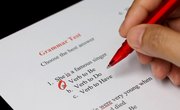Infinitives appear in sentences as root-form verbs introduced by the word "to." For example, "to walk," "to bake," "to ski" and "to learn" are infinitives. It is often confusing to identify the function of infinitives because they are considered verbals, but they never function as verbs. Infinitives function as nouns, adjectives or adverbs in sentences. Additionally, because infinitives begin with the word "to," they are occasionally misidentified as prepositional phrases. A few tests will help you learn how to properly identify infinitives and what their function is in a particular sentence.
Make sure you are looking at an infinitive and not a prepositional phrase by viewing the word or words that appear after the word "to" in the sentence.
If "to" is followed by a pronoun, noun or noun phrase, it is a prepositional phrase, not an infinitive. Preposition Phrase Examples: John gave the book to her. ("her" is a pronoun) John gave the book to Lisa. ("Lisa" is a noun) John gave the book to the pretty, red-headed girl. ("the pretty, red-headed girl" is a noun phrase)
If the word "to" in the sentence is followed by a root-form verb, it is always an infinitive. Infinitive Examples: 1. To meditate is very relaxing. 2. To win, the team must practice. 3. The library must fund-raise to re-open. 4. Bob must pass his oral exam to graduate. 5. Lisa loves to bake. 6. Jack has the persistence to succeed.
Look at the location of the infinitives in sentences 1 and 2 from Step 1.
If the infinitive begins a sentence and is followed by a verb, it functions as a noun. Example: To meditate is very relaxing. ("to meditate" functions as a noun)
If the infinitive begins a sentence, is followed by a comma and a noun or noun phrase, it functions as an adverb. Example: To win, the team must practice. ("to win" functions as an adverb)
Refer back to the location of the infinitives in sentences 3 and 4 from Step 1.
Whether following a verb or noun, if the infinitive ends a sentence and could be moved to the beginning of that sentence by adding a comma, it functions as an adverb.
Example with infinitive following a verb: The library must fund-raise to re-open. To re-open, the library must fund-raise. ("to re-open" functions as an adverb in both sentences)
Example with infinitive following a noun phrase: Bob must pass his oral exam to graduate. To graduate, Bob must pass his oral exam. ("to graduate" functions as an adverb in both sentences)
Review the location of the infinitives in sentences 5 and 6 from Step 1.
If the infinitive ends a sentence but can not be moved to the beginning of that sentence without adding additional words, it is functioning as either a noun or an adjective.
The infinitive functions as a noun when it is preceded by a verb. Example: Lisa loves to bake. ("to bake" functions as a noun)
The infinitive functions as an adjective when it is preceded by a noun or noun phrase. Example: Jack has the persistence to succeed. ("to succeed" functions as an adjective)
Tip
Infinitives can also be phrases that function as nouns or adjectives and follow the same rules for function identification. Examples: The dog wanted to eat steak from the table. ("to eat steak from the table" functions as a noun) Billy was the last boy in school to learn the alphabet. ("to learn the alphabet" functions as an adjective)
Sentences may contain more than one infinitive or infinitive phrase. Example: The instructor's goal was to teach people how to study. (" to teach people" and "to study" are both infinitives)
Warning
In identifying infinitives, do not let sentences with prepositional phrases and infinitives confuse you. Example: The cat goes to the kitchen to eat his breakfast. ("to the kitchen" is a prepositional phrase and "to eat his breakfast" is an infinitive phrase)
Related Articles
References
Tips
- Infinitives can also be phrases that function as nouns or adjectives and follow the same rules for function identification.
- Examples:
- The dog wanted to eat steak from the table. ("to eat steak from the table" functions as a noun)
- Billy was the last boy in school to learn the alphabet. ("to learn the alphabet" functions as an adjective)
- Sentences may contain more than one infinitive or infinitive phrase.
- Example: The instructor's goal was to teach people how to study. (" to teach people" and "to study" are both infinitives)
Warnings
- In identifying infinitives, do not let sentences with prepositional phrases and infinitives confuse you.
- Example: The cat goes to the kitchen to eat his breakfast. ("to the kitchen" is a prepositional phrase and "to eat his breakfast" is an infinitive phrase)
Writer Bio
Laura Payne has been freelance writing for several online publications in her free time since 2006. She holds a Master of Arts in linguistics from Wayne State University and a Bachelor of Arts in journalism from Oakland University. Payne teaches linguistics classes at both universities on an adjunct basis.











